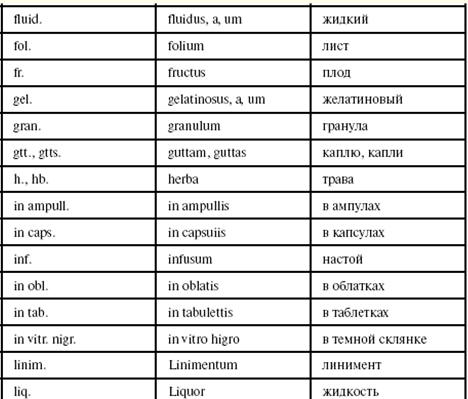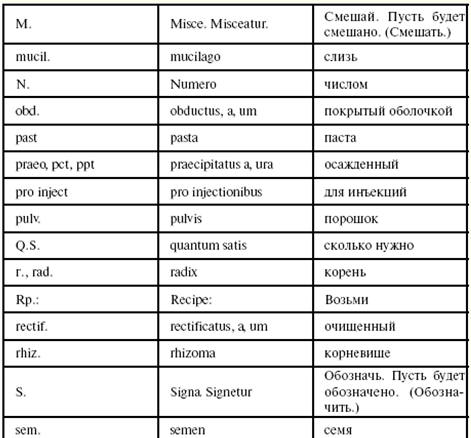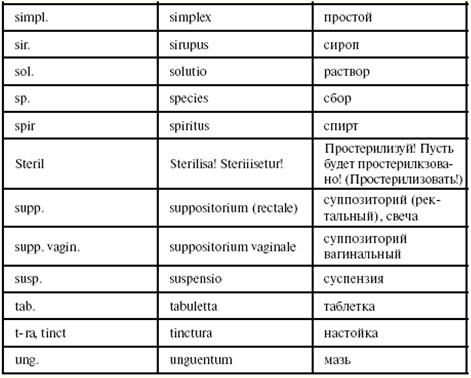
|
|
Lecture notes, cheat sheets
Latin for doctors. Recipe (lecture notes)
Directory / Lecture notes, cheat sheets Table of contents (expand) Lecture number 12. Recipe Recipe (receptum - "taken" from recipio, -ere - "take", "take") - this is a written prescription from a doctor to a pharmacist, drawn up in a certain form, about the manufacture, issuance and method of using a medicine. A prescription is an important legal document that must be drawn up in accordance with official rules. Prescriptions are written on a standard form 105 x 108 mm in size clearly and legibly, without blots and corrections, in ink or a ballpoint pen. Doctors who have the right to issue prescriptions are required to indicate their position and rank in them, sign and certify it with a personal seal. 1. Recipe structure The following parts are usually distinguished in the recipe. 1. Inscriptio - a stamp of a medical institution and its code. 2. Datum - the date the prescription was issued. 3. Nomen aegroti - surname and initials of the patient. 4. Aetas aegroti - the age of the patient. 5. Nomen medici - the surname and initials of the doctor. 6. Praescriptio - "prescription" in Latin, which consists of invocatio - a standard address to a doctor, Rp .: - Recipe - "take" and designatio materiarum - designations of substances indicating their quantity. 7. Subscriptio - "signature" (lit. "written below" the designation of substances) - a part in which some instructions are given to the pharmacist: about the dosage form, the number of doses, the type of packaging, about issuing the medicine to the patient, etc. 8. Signature - a designation, a part that begins with the verb signa or signetur - "to designate", "to designate". Then follows in Russian and (or) the national language an indication to the patient about the method of taking the medicine. 9. Nomen et sigillum personaie medici - the signature of a doctor, sealed with a personal seal. 2. The structure of the prescription line The main content of the recipe is presented in the designatio materiarum. The Latin part of the recipe begins with the appeal Recipe, built according to the rules of Latin grammar. Prescription rules Each drug is prescribed on a separate prescription line and with a capital letter. The names of medicinal substances and plants inside the line are also written with a capital letter. The names of medicinal substances or preparations grammatically depend on their dose (amount) and are put in the gender. P. Prescription rules Recipe: Solutionis Iodi spirituosae 5% 2 ml Tannini 3,0 - Tannin 3,0 Glycerini 10,0 - Glycerin 10,0 Miss. Da - Mix. Give signa. to lubricate the gums - Indicate: to lubricate the gums Recipe: Iodoformii 2,5 - Take: Iodoformii 2,5 Vaselini ad 25,0 - Vaseline up to 25,0 Misce fiat unguentum - Mix to make an ointment Signa: ointment - Designate: ointment The amount of solid or bulk medicinal substances is written out in grams, and the word "gram" is omitted, and the figure is indicated by a decimal fraction, for example: Recipe: Unguenti Zinci 30,0 Recipe: Anaesthesini 0,3 Recipe: Extracti Belladonnae 0,015. The amount of liquid medicines is indicated in volume units - in milliliters, less often in grams, for example: Recipe: Olei Vaselini 30 ml (30,0) Recipe: Extracti Crataegi fluidi 20 ml Recipe: Solutionis Acidi borici 2% - 1,5 ml. If a liquid drug is prescribed in an amount of less than 1 ml, then it is dosed in drops: the word drop (drops) is put in wine. p. units h. (guttam) or pl. hours (guttas); the number of drops is indicated by a Roman numeral. For example: Recipe: Solutionis Adrenalini hydrochloridi 0,1% guttam I Recipe: Olei Menthae piperitae guttas V. When prescribing antibiotics, the dosage is usually indicated in biological units of action (U), for example: Recipe: Benzylpenicillini Natrii 250000 IU If two or more drugs are prescribed in a row in the same amount, then the dose is indicated only once with the last of them, and the word ana (equally) is put in front of the number, for example: Recipe: Amidopyrini Analgini ana 0,25 Da tales doses numero 12 in tabulettis Signa: 1 tablet for headaches. If the recipe does not fit on one line, then it is continued on the next, stepping back from the beginning of the line so that the dose designation is on the right. There are two ways to prescribe certain drugs. Expanded way prescribing a drug involves listing all its ingredients (lat. ingrediens, -ntis - "incoming"), indicating the amount of each of them. Such a prescription often ends with the wording Misce, fiat. For example: Recipe: Xeroformii 1,0 Zinci oxydi 5,0 Lanolins Vasellini ana 10,0 Misce, fiat urtguentum Da Signa: Apply to the affected areas of the skin. RџSЂRё abbreviated way Prescribing a drug in one prescription line indicates the dosage form, the active drug substance and its dose or amount per course of treatment. For example: Recipe: Unguenti Xeroformii 3% 10,0 Detour Signetur: Eye ointment. The abbreviated method of writing prescriptions prevails, since most drugs are standard and come to the pharmacy network in finished form. 3. The use of the accusative case when prescribing tablets and suppositories There are various approaches to naming tablets and suppositories. 1. Medicinal preparations of a combined composition are assigned a trivial and most often abbreviated name, placed in quotation marks: for example, tabulettae "Codterpinum" - tablets "Codterpin"; suppositoria "Neo-anusolum" - candles "Neo-anusol". The trivial names of tablets or suppositories are in them. p. units hours and are inconsistent applications. The dose, as a rule, is not indicated, since it is standard. 2. If the suppositories consist of one active medicinal substance, then its name is attached to the name of the dosage form using the preposition cum and put in the ablative indicating the dose; for example: Suppositoria cum Cordigito 0,0012 - candles with cordigite 0,0012. 3. If the tablets consist of one active medicinal substance, then after indicating the dosage form, its name is put in the genus. n. with the designation of the dose; for example: Tabulettae Cordigiti 0,0008 - Cordigita tablets 0,0008. 4. When prescribing tablets and suppositories in prescriptions in an abbreviated way, the name of the dosage form is put in wines. n. pl. hours (tabulettas, tabulettas obductas, suppositoria, suppositoria rectalia), since it is grammatically dependent on the Recipe, and not on the dose. Eye films (lamellae ophthalmicae) are written out in a similar way (in win. p. pl.): the name of the medicinal substance is introduced using the preposition cum and put in the ablative, for example: Recipe: Lamellas ophthalmicas cum Florenalo numero 30. 5. With an abbreviated way of prescribing tablets and suppositories with one ingredient, you can put the name of the dosage form in Asc. sing. (tabulettam, suppository). In this case, the prescription ends with the standard wording Da (Dentur) tales doses numero... For example: Recipe: Tabulettam Digoxini 0,0001 Da tales doses number 12 Recipe: Suppositorium cum Ichthyolo 0,2 Da tales doses number 10. 6. A prescription for tablets is also common, in which the name of the medicinal substance and its single dose are indicated, ending with the designation of the number of tablets in the standard formulation Da (Dentur) tales doses numero ... in tabulettis. - Give out such doses in number ... in tablets, for example: Recipe: Digoxini 0,0001 Da tales doses numero 12 in tabulettis. 4. Recipe Abbreviations When writing prescriptions, doctors use generally accepted abbreviations. Usually, the names of dosage forms, the names of organs (parts) of plants, as well as standard prescription formulations are abbreviated. Such abbreviations usually contain one or two or three initial letters of the word, for example: h, hb. - herba; M. - Misce; liq. - liquor; inf. - infusum; ol. - oleum. If a word is abbreviated on a syllable that contains several consonants, then all of them are preserved during abbreviation, for example: extr. - extractum; ung. - unguentum. The names of medicinal substances and plants should not be abbreviated. The most important prescription abbreviations
Author: Shtun A.I. << Back: Brief information about dosage forms >> Forward: Chemical nomenclature in Latin. Names of chemical elements, acids, oxides (Names of the most important chemical elements. Names of acids. Names of oxides. Names of salts. Names of anions. Frequency segments in the names of hydrocarbon radicals. Numerals. Adverbs. Pronouns, cardinal and ordinal numbers from 1 to 15. Numeral prefixes of Latin and Greek origin. Adverbs. Pronouns. Present tense of the indicative mood of the active and passive voices)
▪ General biology. Lecture notes ▪ Pedagogical psychology. Lecture notes ▪ Informatics and information technologies. Crib
The existence of an entropy rule for quantum entanglement has been proven
09.05.2024 Mini air conditioner Sony Reon Pocket 5
09.05.2024 Energy from space for Starship
08.05.2024
▪ Electric car Hyundai IONIQ 6 ▪ LG Signature OLED M Wireless TV ▪ Army Night Vision Goggles ENVG-B ▪ Why Men Don't Like Going to Doctors
▪ section of the site Funny puzzles. Article selection ▪ article Russian language and culture of speech. Crib ▪ How many hours a day do you need to sleep? Detailed answer ▪ article Arabic tea. Legends, cultivation, methods of application ▪ article Knots of amateur radio equipment. Mixers, frequency converters. Directory ▪ article Live computer. Focus Secret
Home page | Library | Articles | Website map | Site Reviews www.diagram.com.ua |






 Arabic
Arabic Bengali
Bengali Chinese
Chinese English
English French
French German
German Hebrew
Hebrew Hindi
Hindi Italian
Italian Japanese
Japanese Korean
Korean Malay
Malay Polish
Polish Portuguese
Portuguese Spanish
Spanish Turkish
Turkish Ukrainian
Ukrainian Vietnamese
Vietnamese






 See other articles Section
See other articles Section 